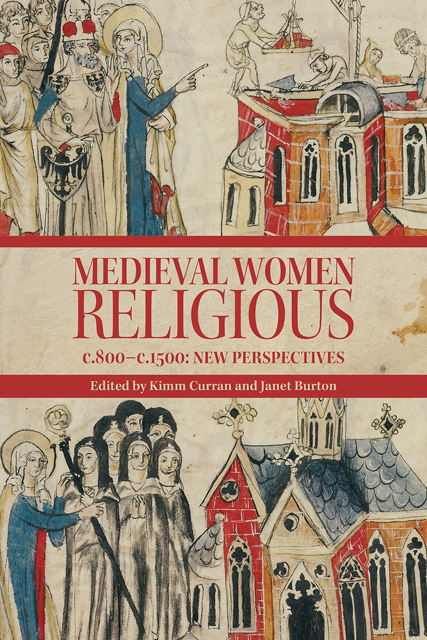Book contents
- Frontmatter
- Contents
- Illustrations
- Contributors
- Preface
- Abbreviations
- Introduction
- 1 Reform, Change, and Renewal: Women Religious in the Central Middle Ages, 800–1050
- 2 New Movements of the Twelfth Century: Diversity, Belonging, and Order(s)
- 3 Change and Renewal: Mendicants and Tertiaries in Later Medieval Europe
- 4 On the Fringes: Anchorites
- 5 ‘Quasi-religious’: Vowesses
- 6 Authority and Agency: Women as Heads of Religious Houses
- 7 Women Religious, Secular Households: The Outside World and Crossing Boundaries in the Later Middle Ages
- 8 Literacies, Learning, and Communal Reform: The Case of Alijt Bake
- 9 Family and Friends: Gift-giving, Books, and Book Inscriptions in Women’s Religious Communities
- 10 Communities of Medieval Religious Women and Their Landscapes
- 11 Materiality and Archaeology of Women Religious
- 12 Between Collective Memory and Individual Remembrance in Women’s Religious Communities
- Select Bibliography
- Index
- Miscellaneous Endmatter
5 - ‘Quasi-religious’: Vowesses
Published online by Cambridge University Press: 08 June 2023
- Frontmatter
- Contents
- Illustrations
- Contributors
- Preface
- Abbreviations
- Introduction
- 1 Reform, Change, and Renewal: Women Religious in the Central Middle Ages, 800–1050
- 2 New Movements of the Twelfth Century: Diversity, Belonging, and Order(s)
- 3 Change and Renewal: Mendicants and Tertiaries in Later Medieval Europe
- 4 On the Fringes: Anchorites
- 5 ‘Quasi-religious’: Vowesses
- 6 Authority and Agency: Women as Heads of Religious Houses
- 7 Women Religious, Secular Households: The Outside World and Crossing Boundaries in the Later Middle Ages
- 8 Literacies, Learning, and Communal Reform: The Case of Alijt Bake
- 9 Family and Friends: Gift-giving, Books, and Book Inscriptions in Women’s Religious Communities
- 10 Communities of Medieval Religious Women and Their Landscapes
- 11 Materiality and Archaeology of Women Religious
- 12 Between Collective Memory and Individual Remembrance in Women’s Religious Communities
- Select Bibliography
- Index
- Miscellaneous Endmatter
Summary
Although vowesses might now be considered comparatively obscure, the vocation was once not only well-known, but indeed fundamental to the social and spiritual fabric of medieval England. A vowess was a woman who had taken a vow of chastity without the accompanying monastic vows of poverty and obedience. These women were almost always widows, although married women did occasionally take the vow if their husbands also embarked on a chaste life. Such vows seem to have been fairly common, especially in the Later Middle Ages, and vowesses were often described as widows who had ‘taken the mantle and the ring’ – an allusion to the ring and mantle bestowed, usually by a bishop, at the vowing ceremony. Allusions to the ring and mantle are peppered throughout medieval English literature, from The Book of Margery Kempe to John Gower's Mirour de l’Omme to Chaucer's ‘Squire of Low Degree’. By at least the fourteenth century, the ring and mantle had become part of the English cultural milieu.
Vowesses interacted with monastic communities and with other women reli¬gious in different ways. Some vowesses seem to have seldom gone near a religious house, while others were fully integrated into convent communities. For those who did choose to participate in monastic life, their quasi-religious status has interesting implications for how they were accommodated within these spaces. This chapter will provide a brief introduction to how women were vowed, the complexities around vowing, and the consequences for how vowesses have been
remembered and researched ever since. It will go on to consider vowesses within the context of women's religious life in England during the Later Middle Ages, using individual case studies to illustrate ways in which vowed women partici¬pated in convent communities.
Vowing Ceremonies
The tradition of veiled widowhood has its origins in the early Church, but the benediction ceremonies at which widows became vowesses appear to have been a peculiarly English phenomenon. Other manifestations of widowed or quasi-mo¬nastic religious life, such as beguines and Franciscan tertiaries, ran in parallel across the European Continent and beyond, with different vocations flourishing in different centuries over the course of the Middle Ages. English vowing cere¬monies date back to at least the seventh century, continuing into the 1530s with a decline that ran parallel to the dissolution of the monasteries.
- Type
- Chapter
- Information
- Medieval Women Religious, c.800-c.1500New Perspectives, pp. 90 - 104Publisher: Boydell & BrewerPrint publication year: 2023



